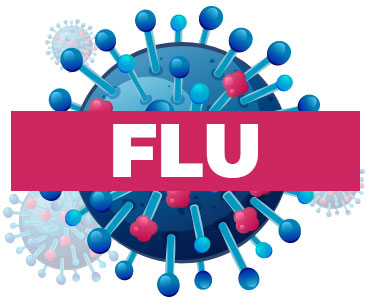Note: The information contained on this page is for archival purposes only and it is no longer maintained or updated.
Is it the flu or COVID-19?
Influenza (flu) and COVID-19 are both contagious respiratory illnesses but are caused by different viruses. COVID is caused by an infection with a coronavirus (SARS-CoV-2) while the flu is caused by an infection with a flu virus.

Is it the flu or COVID-19?
Influenza (flu) and COVID-19 are both contagious respiratory illnesses but are caused by different viruses. COVID is caused by an infection with a coronavirus (SARS-CoV-2) while the flu is caused by an infection with a flu virus.
How can you tell the difference between the flu & COVID?
Since flu and COVID have similar signs and symptoms you can’t tell the difference based on these alone. Specific testing is needed to determine what the illness is and to confirm a diagnosis.
You can be tested for both flu and COVID by a medical professional. Getting treated early for flu and COVID can reduce your risk of getting very sick. Testing can also reveal if a person has both the flu and COVID at the same time, though this is uncommon.
People at Higher Risk of Severe Illness
Both flu and COVID can result in severe illness and complications. Those at increased risk include:
- Older adults
- People with certain underlying medical conditions (including infants and children)
- People who are pregnant
Overall, COVID seems to cause more severe illness in some people. Severe COVID illness may result in hospitalization and death, even in healthy people.
Signs & Symptoms
Compared to people with flu, people infected with COVID may take longer to show symptoms and may be contagious for longer periods of time. Both flu and COVID can have varying degrees of symptoms ranging from none to severe. Common symptoms of both include:
- Fever/chills
- Cough
- Shortness of breath or difficulty breathing
- Tiredness
- Sore throat
- Runny or stuffy nose
- Muscle pain or body aches
- Headache
- Vomiting
- Diarrhea (more frequent in children with flu, but can occur in any age with COVID)
Change in or loss of taste or smell though more frequent with COVID
How long do symptoms appear after exposure & infection?
Similarities
For both flu and COVID, one or more days can pass from when a person becomes infected to when they start to experience symptoms of illness. It is possible to be infected with the virus that causes flu or the virus that causes COVID without experiencing any symptoms.
Differences
If a person has COVID, it could take them longer from the time of infection to experience symptoms than if they have flu.

Flu
Typically a person may experience symptoms anywhere from 1 to 4 days after infection.

COVID-19
Typically, a person may experience symptoms anywhere from 2 to 5 days, and up to 14 days after infection
How does it spread?
Similarities
Both COVID and the flu can spread between people who are near or in close contact with one another. Both are spread mainly by large and small particles containing viruses that are expelled when people with either virus cough, sneeze, or talk. These particles can land in the mouths or noses of people who are nearby and possibly be inhaled into the respiratory tract. In some circumstances, such as indoor settings with poor ventilation, small particles containing virus might be spread longer distances and cause infections.
Most spread is by inhalation of large and small droplets; however, it may be possible that a person can get infected by touching another person (for example, shaking hands with someone who has the virus on their hands), or by touching a surface or object that has virus on it, and then touching their own mouth, nose, or eyes.
Differences

COVID-19
- While the virus that causes flu and COVID are thought to spread in similar ways, the virus that causes COVID is generally more contagious.
- COVID has been observed to spread more easily among large audiences (superspreading events). This means the virus that causes COVID can quickly and easily spread to a lot of people and result in continual spreading among people as time progresses.
- The virus that causes COVID can be spread to others by people before they begin showing symptoms, by people with very mild symptoms, and by people who never experience symptoms (asymptomatic people).
What are the approved treatments & vaccine?

Approved Treatments
Similarities – People at higher risk of complications or who have been hospitalized for COVID or flu should receive recommended treatments and supportive medical care to help relieve symptoms and avoid complications or severe outcomes.
Differences

Flu
- Prescription influenza antiviral drugs are FDA-approved to treat flu. These antiviral drugs are only for treatment of flu and not COVID.
- It is recommended that people who are hospitalized with flu or who have symptoms and are at increased risk of complications receive antiviral drug treatment as soon as possible after illness onset.

COVID-19
- The National Institutes of Health (NIH) has developed guidance and regularly updates its recommendations for treatment of COVID as new evidence or options emerge. This includes antiviral treatment for non-hospitalized people at increased risk for severe COVID and antiviral treatment for people hospitalized with severe COVID. People who are at increased risk of severe COVID should seek treatment within days of when their first symptoms start.

Vaccine
Vaccines for both flu and COVID help protect people from illness, hospitalization and death. They are also approved or authorized for emergency use (EUAS) by FDA.
Differences

Flu
- There are multiple FDA-licensed influenza vaccines produced annually to protect against the four flu strains that scientists expect to circulate each year. Schedule your flu vaccine appointment at VaccineNM.org

COVID-19
- Multiple COVID vaccines are authorized or approved to help prevent severe illness and hospitalizations. Find more information on COVID vaccine and booster recommendations at the CDC’s website. Schedule your COVID vaccine appointment at VaccineNM.org
Copyright New Mexico Department of Health
